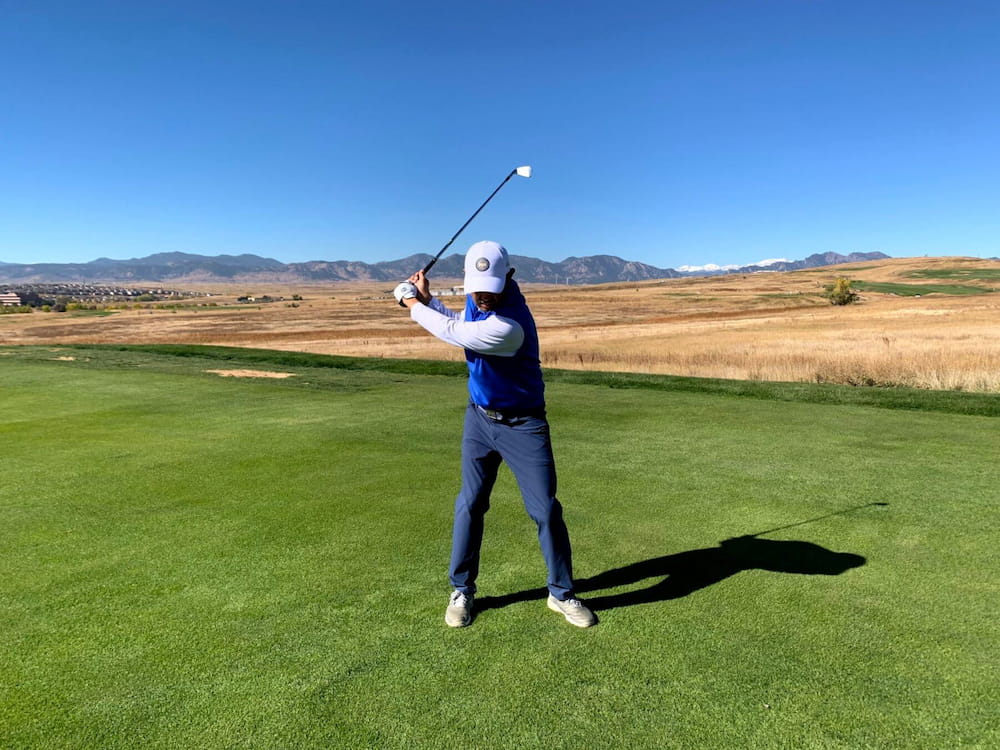When I see a long backswing, I typically see a swing that is hard to replicate over and over again for an average golfer. Many of these players know they have a long backswing because they can see their clubhead shadow in front of them at the top of their golf swing.
The results vary which is not what you want in your golf swing because it will cost you almost everything in your swing. This means a disruption in your timing and sequencing and most likely you will cast the club during the downswing. Overswinging can also tire you out if you feel you have to muscle your way through every shot.
Most golfers try to shorten the backswing but it is very difficult to do so because it throws off the current rhythm in their golf swing. What I mean by this is that it will feel very uncomfortable to shorten it and to transition into the downswing.
What I teach my students is to learn how to release the club and to get their lower body involved earlier in their swing. Let’s get in depth about what this means.
Releasing the Club
What I check to see is how tight my students are gripping the club at set up and how they take the club back at takeaway. Most likely the grip pressure is tight and they hinge their wrists to take the club back. Because bad habits are hard to break, I’ll check their grip and maybe tweak it to put the club more in the fingers instead of the palm. I want the club to feel different to them so they can take it back differently than they are used to (hence, breaking bad habits).
I’ll explain that the clubhead should feel heavier so they can feel it more and create momentum at takeaway. This momentum and release will make you feel like you don’t have to put so much power behind your turn (over-extension). Waggling the club at set-up is a good way to remind yourself of this. When you start your takeaway, let the clubhead start your swing. It will almost feel like you are “flicking” the clubhead back.
This is what we need to do because you have started the process to release the club. You will feel that the clubhead has created more speed right from the start and your arms and shoulders are along for the ride. You will also feel that your takeaway is more shallow rather than picking up the club.
Check Your Setup
Upon setting up their golf stance, I first have my students bring in the arms closer to their body. I then have them release the club back and forth. What they notice is that they are not using their arms nor picking up the club any longer. Make the club part of the body. If the clubhead moves, the body will follow.
Transfer Your Weight Earlier
To make it simple after releasing the club properly, we need to focus on a small hip turn that will result in feeling weight into your trail leg. You should feel weight onto the “ball” of your trail foot immediately. I mean that you will feel a good amount even before your hands go past your back leg (clubhead should have passed however).
Not only are we loading up to create power but this should allow you to create better tempo and an easier transition because this should take your tight grip out of your swing. As soon as you feel most of the weight onto the front part of your trail foot, we need to use that feeling and use the ground to push off…earlier than ever.
This will create your lower body to start your downswing and create the proper sequence. If this happens, we need to let the hands and club follow behind which will create the proper lag and flex in your shaft during the downswing.
Doing this will create all that weight to transfer into the lead leg right before ball contact which means that you have fully released the club at the most important part of the swing. Impact.
What I want my students to feel from this is to feel that their swing feels a lot shorter overall while feeling comfortable and more powerful going through impact. Starting off with a wedge in your hands and hitting pitch shots is a great way to make this feel comfortable. They realize that the ball can go a lot further and more consistently by using their lower body more and “swinging” a lot less.
Summary on Shortening Your Golf Swing
First, look to break some bad habits. A great way of forcing your to do so from the very beginning is to change your grip and place the club grip more in your fingers to make the club feel heavier, allowing for stronger momentum and reducing the need to overextend your backswing.
Secondly, upon your setup, practice swinging the clubhead back and forth. You should feel that you can do this without shifting your arms or picking up the club.
Lastly, ensure you transfer your weight earlier to your back foot. This will result in an earlier transition which will create lag and flex in your club shaft during your downswing.
What’s interesting is that when my students shorten their swings to the point where it feels uncomfortable, their swing is actually perfectly extended. So don’t fret if it feels awkward at first. Stick with it and check out the results later in your practice session at the range. I hope you’ll see just as much length and consistency without getting tired so quickly from overswinging.


